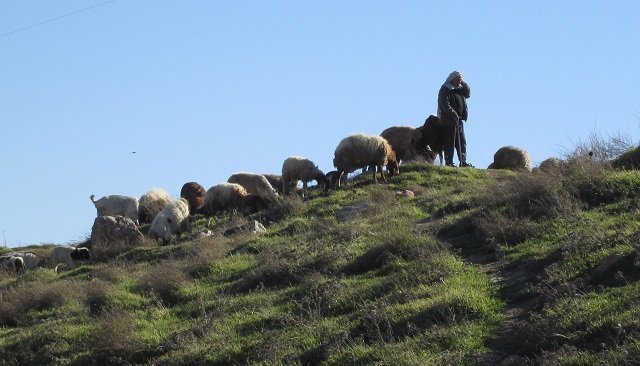I will never forget the first time I saw a real shepherd. I was leading my first trip to Israel/Palestine of a group of students from Luther Seminary. It was toward the end of the trip and our guide took us to a scenic spot for lunch overlooking Jerusalem. There we were, eating delicious Jerusalem bread (I suspect that our lunch consisted of more than bread, but the bread is amazing), I turned around and up on the hill behind us was a shepherd — with sheep!
I dropped my bread on the spot, grabbed my phone, and started taking photos. You see, my Ph.D. dissertation was on John 10, the Shepherd Discourse, and yet growing up in the Bay Area of California, going to college outside of Chicago, spending a few summers in Los Angeles, and doing a seven-year stint in Atlanta, in those environs, shepherds were not necessarily a frequent sight.
At first, the scene lacked an anticipated and presumed pastoral sense because this particular shepherd was talking on his cellphone. I waited patiently, however, assuming he had important business to take care of — perhaps arranging a coffee break — and captured what was, I think, a rather ideal image of John 10.
I use these photos all the time now in my teaching on John and not just because it’s a relatively good photo or that I am presenting on my dissertation. Gah! That would put the audience to sleep. I use it because often I need it. I need its reminder — of my God who came to me, to us, in the flesh. My God who knows me. My God who found me.
All too often our sermons on this Good Shepherd Sunday devolve into attempts at convincing our congregations that we have an adequate understanding of shepherding in ancient Palestine. Unless you grew up with sheep, you don’t. Or, our interpretations dislodge this intimate portrayal of Jesus from its origins. Jesus does not all of a sudden or out of the blue decide that describing himself as a shepherd is a good idea. He’s on a mission. A John 3:16 mission. A John 10:16 mission. He’s brought the blind man into his fold. And with only one more miracle left in his pocket, the disciples need to know that they are his mission, too.
Jesus as shepherd in John is the one “I AM” that holds intimacy and apostolicity together. That holds the extraordinary tension of John 20:30-31 together — this book is meant both to sustain your believing and invite new believers. That holds “come and see” and “as the Father has sent me, so also I send you” together.
That is, in Jesus as the Shepherd is revealed both our identity and our calling. That in Jesus as the shepherd is realized both our promise and our purpose. That in Jesus as the shepherd we recognize that we are deeply known and yet, at the same time, we trust that so many others so desperately need to be known.
It’s the kind of knowing when you can pick out your kid, covered in gear, at a hockey or football game.
It’s the kind of knowing when you get a text from your son and know something is not quite right. And you call him right away.
It’s the kind of knowing when the one you love says your name. And they say it in a way that no one else does.
It’s the kind of knowing when you know you will never be let go.
And, it’s the kind of knowing that wishes that kind of knowing for others. It’s the kind of knowing that wants to share that knowing with others. It’s the kind of knowing that needs to invite others.
This is Jesus as the Good Shepherd — who tends his sheep but is always going out to find the abandoned. Those thrown out, cast out, tossed out — and expects us to do the same.
This is Jesus as the Good Shepherd who loves his sheep, who calls them by name, but is constantly going out to find the one who finds herself alone at the well, who finds himself passed over and passed by day after day, who lies dead in the tomb, the tombs that determine some are better than others, more worthy than others, more loved than others. Those tombs from which we try to escape, from which we so desperately try to come out, but only the Shepherd’s voice, knowing our name, can free us. Can save us.
This is Jesus as the Good Shepherd, who, last Sunday, reminded us that we are the good shepherd now. Tending sheep, feeding Jesus’ lambs, and always on the lookout for those who need the protection of Jesus’ fold.
But are we the good shepherd Jesus needs us to be? Or do we leave it all to Jesus? Satisfied with stained-glass windows and a sin-stained belief that the love Jesus has for us is ours alone.
Don’t let another Good Shepherd Sunday pass on by, Dear Working Preachers, without abiding in how deeply you are known — and how deeply others need to feel the same.
Karoline

